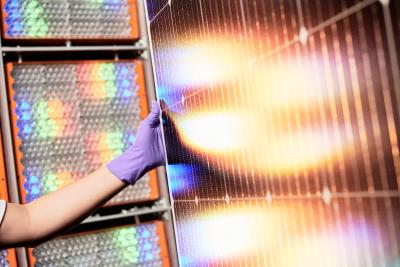 Oxford Photovoltaics (Oxford PV) was founded in 2010 as a spin-out from the University of Oxford, to commercialize a new technology for thin-film solar cells. It was amongst the first in the world to recognize the potential of perovskites to act as a low-cost, highly efficient solar cell absorber material to convert sunlight into electricity.
Oxford Photovoltaics (Oxford PV) was founded in 2010 as a spin-out from the University of Oxford, to commercialize a new technology for thin-film solar cells. It was amongst the first in the world to recognize the potential of perovskites to act as a low-cost, highly efficient solar cell absorber material to convert sunlight into electricity.
The Company focuses on developing and commercializing a perovskite-based solar technology. Its research and development site in Oxford, UK, and pilot and production line near Berlin, Germany, enable the accelerated transfer of Oxford PV's technology into industrial-scale perovskite-on-silicon tandem solar cell manufacturing.
The Company exclusively licensed the rapidly growing portfolio of fundamental intellectual property developed by its academic team.
Oxford PV has acquired the former thin-film production site of Bosch Solar in Germany, to establish a fab with pilot-scale capacity for perovskite wafers. To that end, the Company also received funding from the European Investment Bank (EIB), to support the commercialization of its perovskite-on-silicon tandem solar cell technology.
Unit 7–8 Oxford Pioneer Park
Mead Road, Yarnton
Kidlington, Oxon
OX5 1QU
United Kingdom
Oxford PV and Fraunhofer ISE announce full-sized tandem PV module with 25% efficiency
A research team from the Fraunhofer Institute for Solar Energy Systems ISE has reported a PV module using perovskite silicon tandem solar cells from Oxford PV with an efficiency of 25% and an out-put of 421 watts on an area of 1.68 square meters, stating it is a record efficiency for a silicon perovskite tandem solar module in industrial format.
For the manufacturing process, the researchers used equipment at Fraunhofer ISE's Module-TEC that is already used in mass production and optimized the processes for the tandem technology.
Researchers examine shingling as an interconnection method for perovskite-silicon tandems
A group of scientists from Germany's Fraunhofer Institute for Solar Energy Systems (Fraunhofer ISE), with support from Oxford PV Germany, have examined shingling as an interconnection method for perovskite-silicon tandem (PVST) cells.
Full-format perovskite-silicon tandem shingle modules produced at Fraunhofer ISE in collaboration with Oxford PV. Image from Solar Energy Materials and Solar Cells.
The scientists explained that the combination of PVST cells with shingling allows boosting the module efficiency even further due to the increase of the photoactive area through the absence of cell gaps. They went on to say that shingling suits the temperature limitations of the PVST cells since the main factor for the choice of the processing temperature is the curing conditions of the electrically conductive adhesive.
Oxford PV's perovskite-on-silicon tandem solar cells used in the Bridgestone World Solar Challenge
Oxford PV has announced that its perovskite-on-silicon tandem solar cells will be deployed for the first time on the race car of the Top Dutch Solar Racing team for the upcoming Bridgestone World Solar Challenge.
Taking place between the 22nd and 29th of October 2023, the competition brings some of the world’s greatest scientific and engineering talent to Australia to travel 3,000 kilometers in a vehicle powered only by the energy of the sun. University-affiliated teams push the limits of technological innovation and travel the outback in solar-powered vehicles that they have designed, engineered and ultimately built themselves.
Researches develop low-temperature processes to reduce silver use in tandem perovskite-silicon solar cells
Researchers from the Fraunhofer Institute for Solar Energy Systems (Fraunhofer ISE) and Oxford PV Germany have developed low temperature manufacturing processes for perovskite silicon tandem cells and heterojunction solar cells. The novel techniques are reportedly able to reduce silver consumption and avoid lead-containing soldering materials.
The scientists developed two different processes: front-side metallization at very low temperatures for full-size perovskite silicon tandem solar cells; and the interconnection to high-efficiency full-format demonstrator modules with an output power of more than 400 W.
Oxford PV announces new efficiency record
Oxford PV has announced 'a new world record for the efficiency of a commercial-sized solar cell'. The efficiency record was achieved on a commercial-sized ‘M4’ (258.15 cm2) solar cell. The cell is a 2T device made by depositing a perovskite thin-film cell onto a conventional silicon heterojunction cell.
The record-breaking solar cell converted 28.6% of the sun’s energy into electricity, as independently certified by Fraunhofer ISE. The solar cell was produced at Oxford PV’s integrated production line in Brandenburg an der Havel, Germany. The factory has commenced initial production of the company’s tandem solar cells for integration by solar module manufacturing partners and is ramping up to higher volumes. The site, operational since 2017, houses the world’s first volume manufacturing line for perovskite-on-silicon tandem solar cells.
Pagination
- Previous page
- Page 2
- Next page





